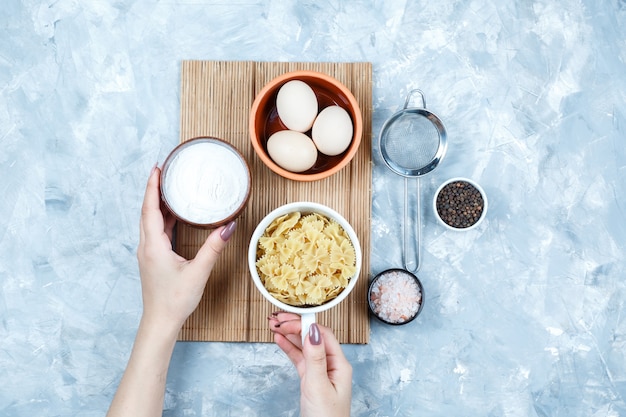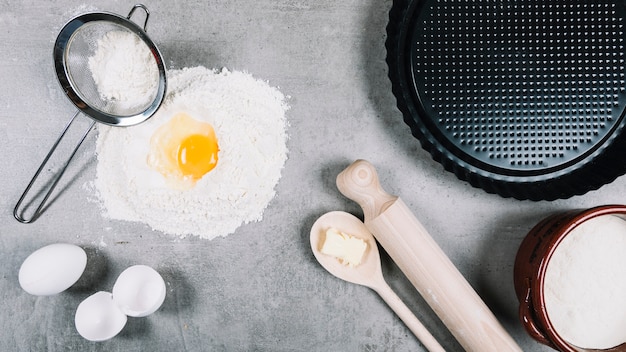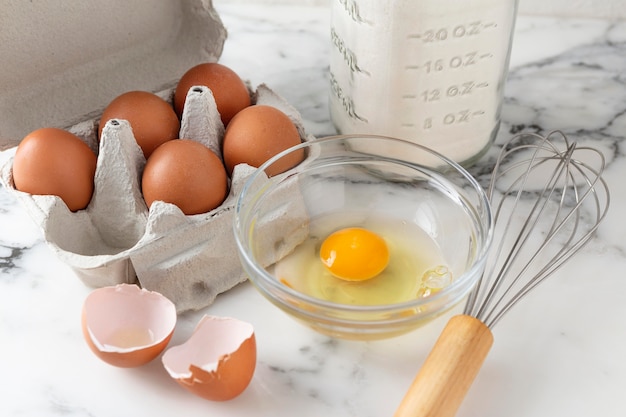The Equipment: Your Kitchen Allies

Let's start with the pan. I'm a big fan of cast iron skillets. They distribute heat evenly and retain it well, which is key to getting that lovely golden brown crust on your egg whites. But if you're just starting out, a non-stick pan is a great beginner-friendly option. It helps prevent sticking and makes clean-up a breeze.
Next up, the spatula. You want something flexible, thin, and heat-resistant. I'm a fan of silicone spatulas, but a good old metal one will do the trick too. The goal is to have a spatula that you can smoothly slide under the egg without breaking the yolk.
The Eggs: Choosing Your Champions
Now, let's talk about the star of the show: the eggs. Over the years, I've tried eggs from all over, and I’ve learned that freshness makes a huge difference. Farm-fresh eggs, especially from chickens that roam free and have a healthy diet, are usually the best choice. Their yolks are vibrant, rich, and their whites are thick and firm.Don't just grab any old eggs from the supermarket, though. Look for eggs that still have their "bloom" – that delicate powdery coating on the shell. It protects the egg from bacteria, so it's a sign of freshness. Also, always check the "best-by" date. You want eggs that are as close to that date as possible.
(Part 2)The Technique: A Symphony of Heat and Timing

Getting Started: The Heat is On
Here's the tricky part: finding the right temperature. Too low, and the egg whites will cook slowly and become rubbery. Too high, and the whites will burn before the yolks have a chance to set properly. I've found that medium-low heat is the sweet spot.Remember, you want a hot pan to start. So, place your pan over medium-low heat and let it warm up for a couple of minutes. The pan should be warm to the touch, not scorching hot.
The Crack: A Delicate Dance
Now for the moment of truth: cracking the egg. I like to crack my eggs onto a flat surface, like a plate or a cutting board. This helps me avoid getting bits of shell in the egg. You can use your hands or a spoon to crack the eggs, but I prefer using my hands. It gives me a better feel for the egg and helps me crack it more evenly.The Pan: A Place for the Egg to Shine
Add a dollop of butter or oil to your pan. A thin layer is all you need. The fat prevents the egg whites from sticking to the pan and ensures smooth, even cooking.The Egg: The Star of the Show
Here's the real test of your egg-cooking prowess:For an over-medium egg, you want to cook the whites for about 2 minutes on each side. This gives them time to set and turn that beautiful golden brown color.
After the first 2 minutes, flip the egg and cook it for another 1-2 minutes. The yolk should still be runny, but the whites should be cooked through. The key is to constantly keep an eye on the egg. You'll want to make sure the whites don't start to brown too much and the yolk doesn't become too hard.
(Part 3)The Finish: A Culinary Symphony

The Plate: A Stage for Your Creation
Carefully slide the egg onto your plate. You want to keep the yolk intact, so use a flexible spatula and gently lift it off the pan.The Garnish: Adding a Touch of Flair
Now for the fun part: adding your favorite toppings. I'm a big fan of salt, pepper, and a sprinkle of chopped fresh herbs like chives or parsley. But get creative! You could add a dollop of sour cream, a sprinkle of cheese, or a drizzle of hot sauce. The possibilities are endless.Personally, I prefer to keep things simple. A little salt and pepper enhance the egg's natural flavors. But hey, that's just me. Experiment and find what makes your taste buds sing.
(Part 4)The Aftermath: Enjoying Your Creation
Now, it's time to savor your culinary triumph. Take a moment to appreciate the rich, creamy yolk and the perfectly cooked whites.Remember, the perfect over-medium egg is a delicate balance of flavors, textures, and cooking times. There's no one-size-fits-all approach. It takes practice, patience, and a sprinkle of culinary magic.
Keep experimenting, keep exploring, and keep perfecting your over-medium egg game. You might surprise yourself with what you can create.
(Part 5)The Secrets: Tips and Tricks From the Kitchen
Here are some tips I’ve picked up along the way:- Use cold eggs: It might sound counterintuitive, but cold eggs are actually better for cooking over-medium. The whites set more evenly, and the yolks stay runny longer.
- Don't overcrowd the pan: Give each egg its own space to cook. If you crowd the pan, the eggs won't cook evenly.
- Watch the bubbles: When you see tiny bubbles forming around the egg whites, it means they're almost done cooking.
- Use a lid: If you want to cook your eggs a little faster, cover the pan with a lid. This will trap the heat and help the whites cook more quickly.
The Variations: Expanding Your Culinary Horizons
The over-medium egg is a versatile ingredient. You can use it in countless ways to create delicious dishes.Here are some ideas to get your creative juices flowing:
Breakfast: The Classic
- Eggs Benedict: A classic brunch dish featuring poached eggs on english muffins topped with hollandaise sauce and ham. poaching eggs might sound intimidating, but it's easier than you think! Just gently simmer the eggs in water until the whites are set and the yolk is still runny.
- Breakfast Burrito: A satisfying breakfast wrapped in a warm tortilla filled with eggs, cheese, beans, and other fillings. This is a great way to use leftover eggs, and you can customize it with your favorite ingredients.
- Eggs and Toast: A simple and satisfying breakfast. This is a great option if you're short on time, and it's always a crowd-pleaser.
Lunch: A Delightful Option
- Salads: Add a poached egg to your salad for a boost of protein and richness. It's a delicious and satisfying way to add a touch of indulgence to your salad.
- Sandwiches: A perfectly cooked over-medium egg makes a delicious addition to any sandwich. Think about adding it to a BLT, a grilled cheese, or even a simple ham and cheese sandwich.
Dinner: An Unexpected Twist
- Pasta: Add a poached egg to your pasta dish for a touch of decadence. It adds a creamy, rich texture to any pasta dish.
- Risotto: A poached egg adds richness and creaminess to risotto. It creates a luxurious and comforting dish that's perfect for a special occasion.
The Troubleshooting: When Things Go Wrong
Let's face it, even the most experienced cooks have kitchen mishaps. Here's what to do when things go wrong:The Egg Whites are Too Hard
If your egg whites are overcooked and too hard, there are a few things you can try to salvage your creation. You could try adding more moisture to the dish, like a dollop of sour cream or a sprinkle of cheese. Or, you could blend the egg into a sauce, like a hollandaise or a béarnaise sauce.
The Yolk is Too Hard
If the yolk is too hard, it means you overcooked the egg. You could try to salvage it by adding it to a dish that calls for a cooked yolk, like scrambled eggs or an omelet.
The Egg Sticks to the Pan
This usually happens when the pan isn't hot enough or when you don't use enough oil. Try adding a little more oil to the pan or increasing the heat. Next time, be sure to heat the pan for a few minutes before adding the oil and egg.
(Part 8)The FAQs: Answering Your Questions
Here are some frequently asked questions about over-medium eggs:1. What is the difference between over-medium and medium?
An over-medium egg has a slightly firmer yolk than a medium egg. With an over-medium egg, the yolk is still runny, but it's not quite as runny as a medium egg.
2. How long should I cook an over-medium egg?
The cooking time for an over-medium egg will vary depending on the heat of your pan. But, generally speaking, you'll want to cook the whites for about 2 minutes on each side.
3. What is the best way to tell if an egg is overcooked?
The yolk should still be runny, but it should not be jiggly. The whites should be set and slightly firm, but not rubbery.
4. Can I cook over-medium eggs in the oven?
You can, but it's not the best method. The best way to cook an over-medium egg is on the stovetop in a frying pan. It allows you to have greater control over the cooking process and ensures that the whites are cooked evenly.
5. What is the best way to store eggs?
Eggs should be stored in the refrigerator, ideally in their original carton. Keep them in the coldest part of the fridge, but don't wash them until you're ready to use them. Washing eggs can remove their protective bloom and make them more susceptible to bacteria.
(Part 9)The Legacy: Passing the Torch
I hope this guide has helped you understand the secrets of the perfect over-medium egg. It's a journey that takes time, patience, and a little bit of love. But, trust me, it's worth it.Now, go forth, my culinary friends, and spread the joy of the over-medium egg. Let's inspire a new generation of egg lovers, one runny yolk at a time.
Everyone is watching

Corn on the Cob: The Ultimate Guide to Perfectly Cooked Ears
Healthy MealsAh, corn on the cob. Just the name evokes images of sunny days, barbecues, and that sweet, juicy flavour that ...

Perfect Pork Roast Oven Cooking Time: A Guide to Delicious Results
Healthy MealsThere's something truly satisfying about a perfectly roasted pork. The aroma alone is enough to make your mout...

Ham Cooking Time: How Long to Bake, Smoke, or Boil a Delicious Ham
Healthy MealsAh, ham. It's a classic, isn't it? A real crowd-pleaser, especially around holidays. And when done right, it'...

Scallops: The Ultimate Guide to Perfect Cooking
Healthy MealsAh, scallops. Those delicate, sweet, and utterly delicious morsels of the sea. They hold a special place in my...

Spaghetti Squash: The Ultimate Guide to Cooking and Serving
Healthy MealsRemember that time you saw spaghetti squash at the supermarket, looking all bumpy and strange, and thought, "W...
